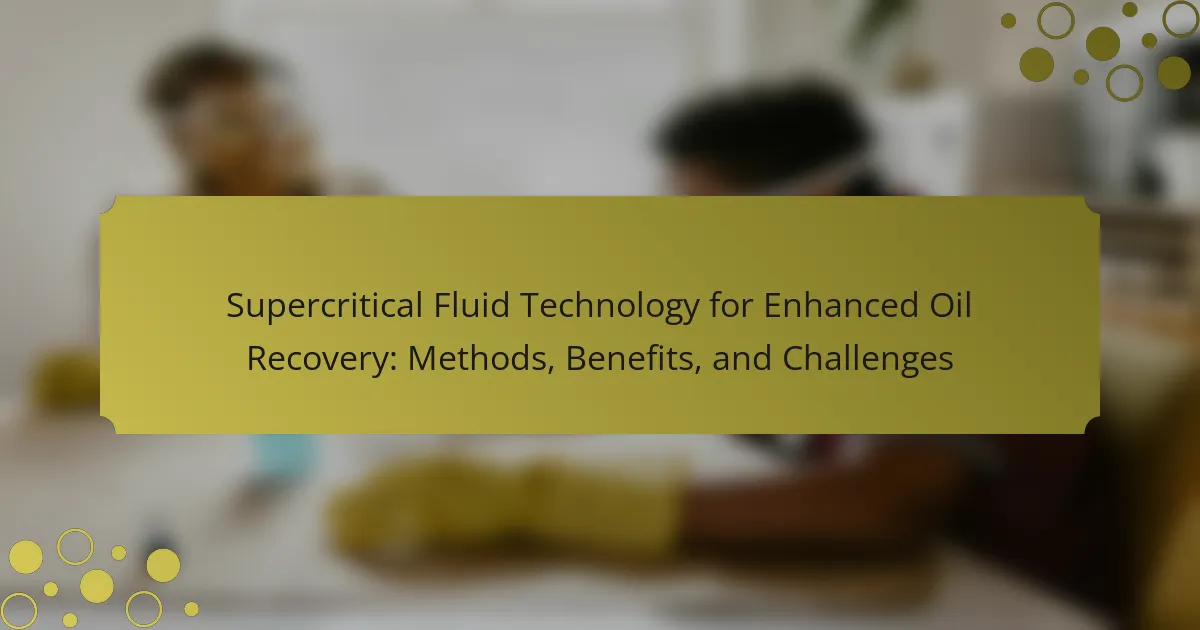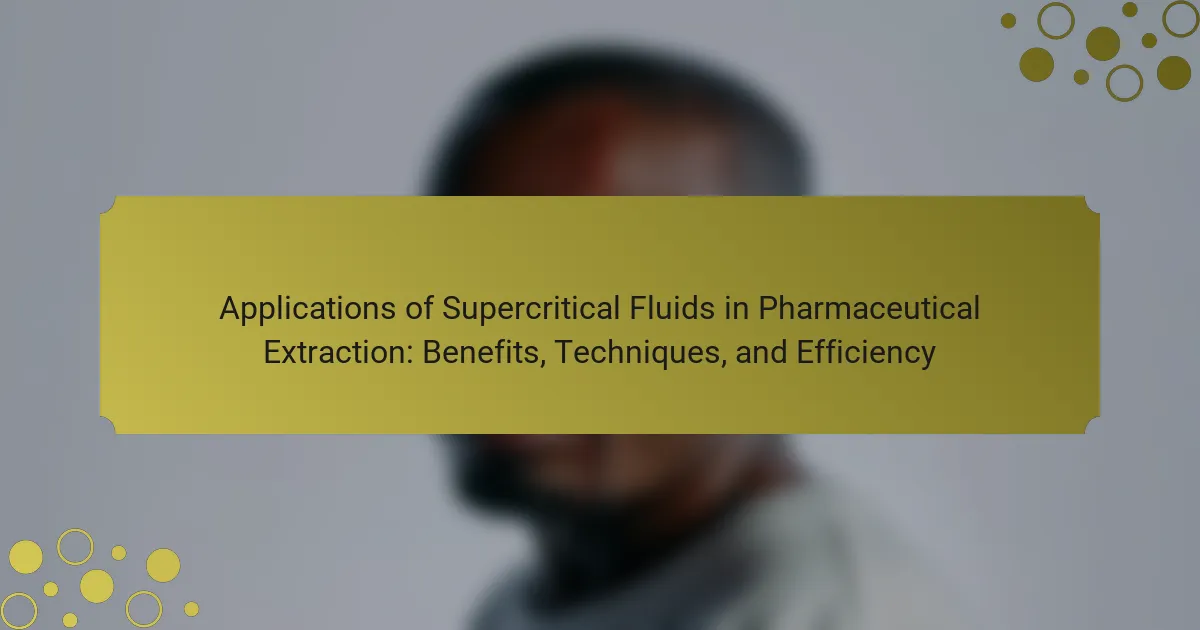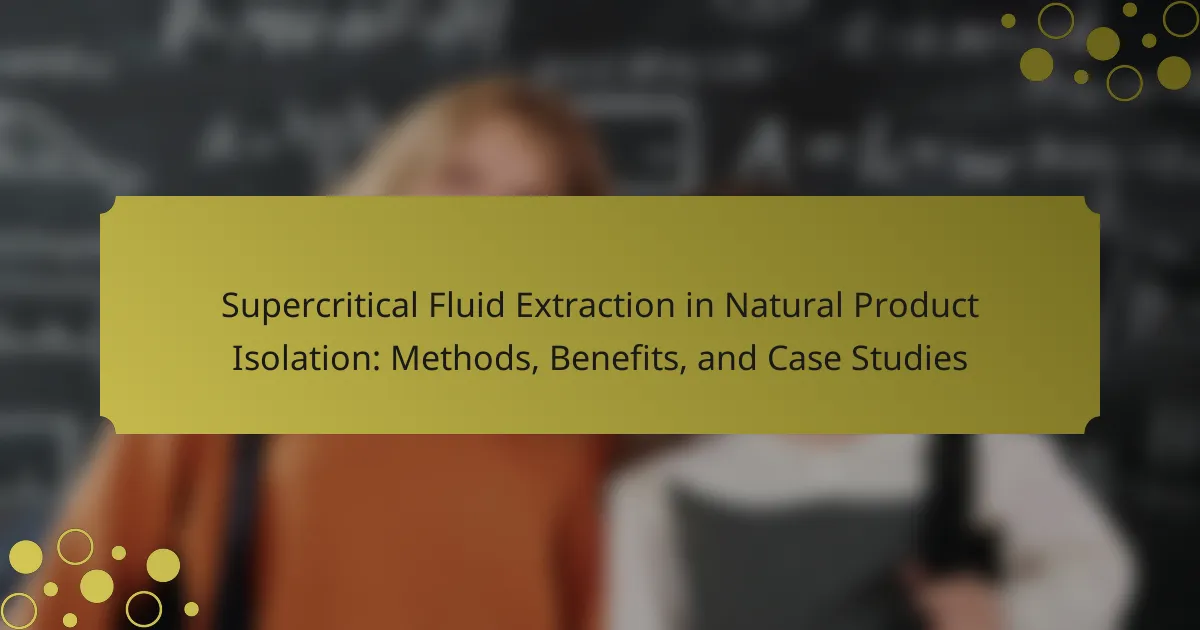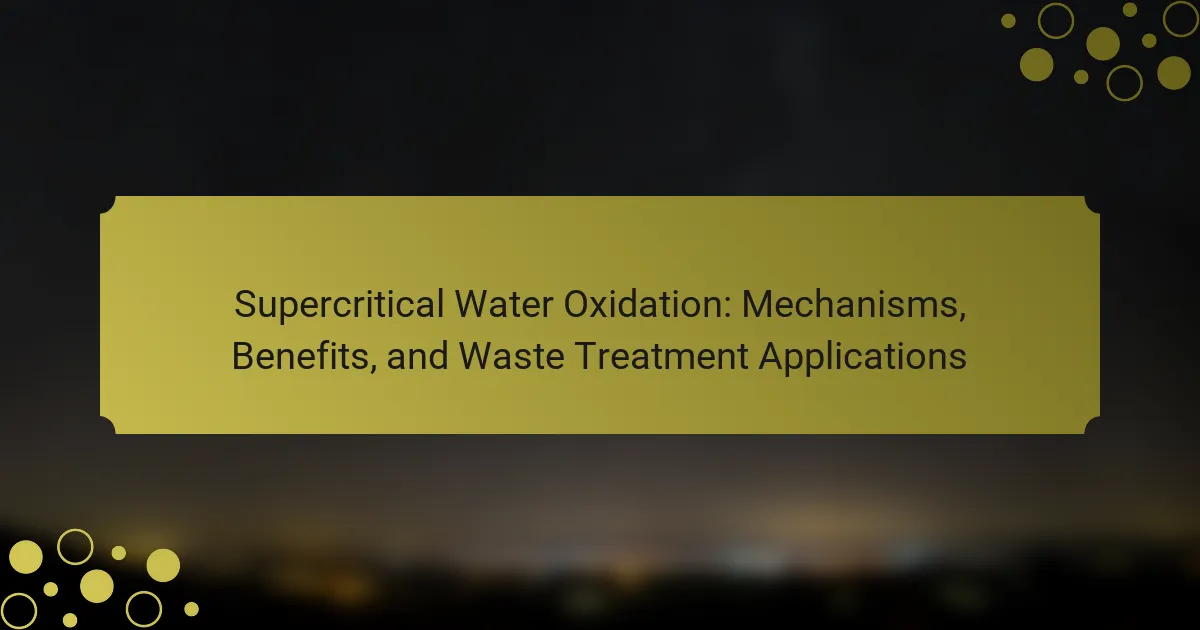Supercritical carbon dioxide (SC-CO2) is a unique state of carbon dioxide that combines properties of both gas and liquid, making it an effective solvent in food processing. This method is utilized for extraction, sterilization, and preservation, allowing for the isolation of flavors, oils, and nutrients without harmful chemicals. SC-CO2 operates under high pressure and temperature, enhancing product quality and extending shelf life while maintaining food integrity. Despite its advantages, safety considerations such as high-pressure storage, temperature control, and oxygen displacement must be addressed to ensure safe application in food processing. Overall, SC-CO2 presents a sustainable and efficient alternative for improving food processing methods.
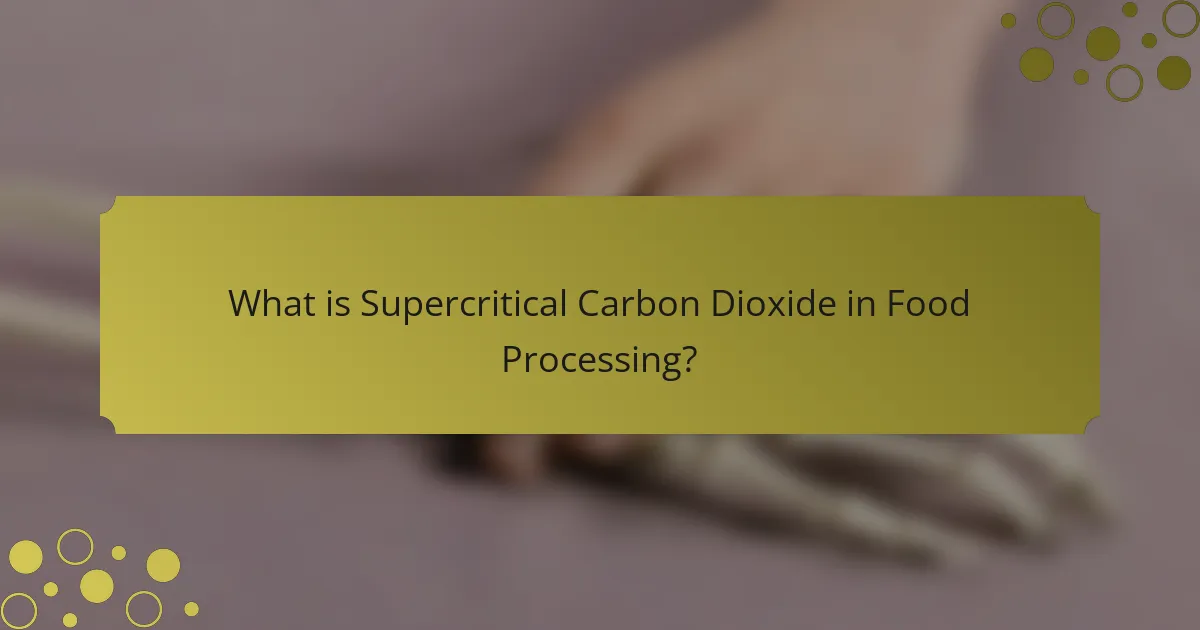
What is Supercritical Carbon Dioxide in Food Processing?
Supercritical carbon dioxide (SC-CO2) is a state of carbon dioxide where it exhibits properties of both a gas and a liquid. In food processing, SC-CO2 is used as a solvent for extraction, sterilization, and preservation. This method allows for the extraction of flavors, oils, and nutrients from food without the use of harmful chemicals. SC-CO2 operates at high pressure and temperature, enabling efficient extraction while maintaining the integrity of the food. Research indicates that this process can enhance product quality and shelf life. SC-CO2 is recognized for its low toxicity and environmental benefits, making it a sustainable option in food processing.
How does supercritical carbon dioxide work in food processing?
Supercritical carbon dioxide (SC-CO2) acts as a solvent in food processing. It exists in a state where it has properties of both a liquid and a gas. This unique state allows SC-CO2 to extract flavors, oils, and nutrients efficiently from food materials. The extraction process occurs at elevated pressures and temperatures, which enhance the solubility of compounds. SC-CO2 is non-toxic and leaves no harmful residues, making it safe for food applications. Studies show that SC-CO2 can effectively replace chemical solvents in extracting essential oils and natural flavors. Its use in food processing also reduces environmental impact by minimizing waste and energy consumption.
What are the key properties of supercritical carbon dioxide?
Supercritical carbon dioxide (scCO2) exhibits unique properties that make it valuable in various applications. It has a density similar to that of liquids while maintaining gas-like viscosity. This allows scCO2 to dissolve non-polar compounds effectively. The critical temperature of scCO2 is 31.1°C, and the critical pressure is 73.8 atm. These conditions enable scCO2 to act as a solvent without the need for harmful organic solvents. Additionally, scCO2 is non-toxic and environmentally friendly. Its ability to penetrate solids facilitates efficient extraction processes. These properties are crucial in food processing, enhancing extraction efficiency while ensuring safety and sustainability.
How is supercritical carbon dioxide generated for food processing?
Supercritical carbon dioxide is generated for food processing by increasing carbon dioxide pressure and temperature. Typically, carbon dioxide is pressurized to above 73.8 atmospheres. This pressure causes the carbon dioxide to transition from a gas to a supercritical fluid. The temperature is also raised above 31.1 degrees Celsius, the critical temperature of carbon dioxide. In this supercritical state, carbon dioxide exhibits unique properties, acting as both a gas and a liquid. This allows it to dissolve substances effectively. The process is often conducted in specialized extraction equipment designed for food applications. Supercritical carbon dioxide is recognized for its efficiency and lower environmental impact compared to traditional solvents.
What advantages does supercritical carbon dioxide offer in food processing?
Supercritical carbon dioxide (SC-CO2) offers several advantages in food processing. SC-CO2 is a non-toxic and environmentally friendly solvent. It effectively extracts flavors, colors, and nutrients from food without leaving harmful residues. The process operates at relatively low temperatures, preserving the quality and nutritional value of the food. SC-CO2 also reduces the need for chemical additives, enhancing product safety. Additionally, it can improve shelf life by eliminating microbial contamination. Research indicates that SC-CO2 extraction yields higher quality products compared to traditional methods. These advantages make SC-CO2 a valuable tool in modern food processing.
How does it enhance extraction processes?
Supercritical carbon dioxide enhances extraction processes by acting as a solvent at low temperatures. It effectively dissolves non-polar compounds, making it ideal for extracting flavors and essential oils. The supercritical state allows for high diffusion rates, improving the efficiency of the extraction. This method reduces the need for harmful organic solvents, promoting safety and environmental sustainability. Research indicates that supercritical CO2 extraction can yield higher quality products with better flavor profiles. Studies show that it can extract up to 95% of essential oils from plant materials, demonstrating its effectiveness.
What are the benefits for food preservation and safety?
Food preservation and safety enhance the longevity and quality of food products. Effective preservation methods prevent spoilage and reduce foodborne illnesses. Supercritical carbon dioxide (SC-CO2) is a non-toxic method for food preservation. It inhibits microbial growth and enzymatic reactions that lead to spoilage. SC-CO2 treatment can extend the shelf life of various foods, including fruits, vegetables, and meats. Studies show that SC-CO2 maintains the nutritional quality of food better than traditional methods. Additionally, it leaves no harmful residues, ensuring food safety. This method is increasingly recognized for its effectiveness and environmental benefits in food processing.
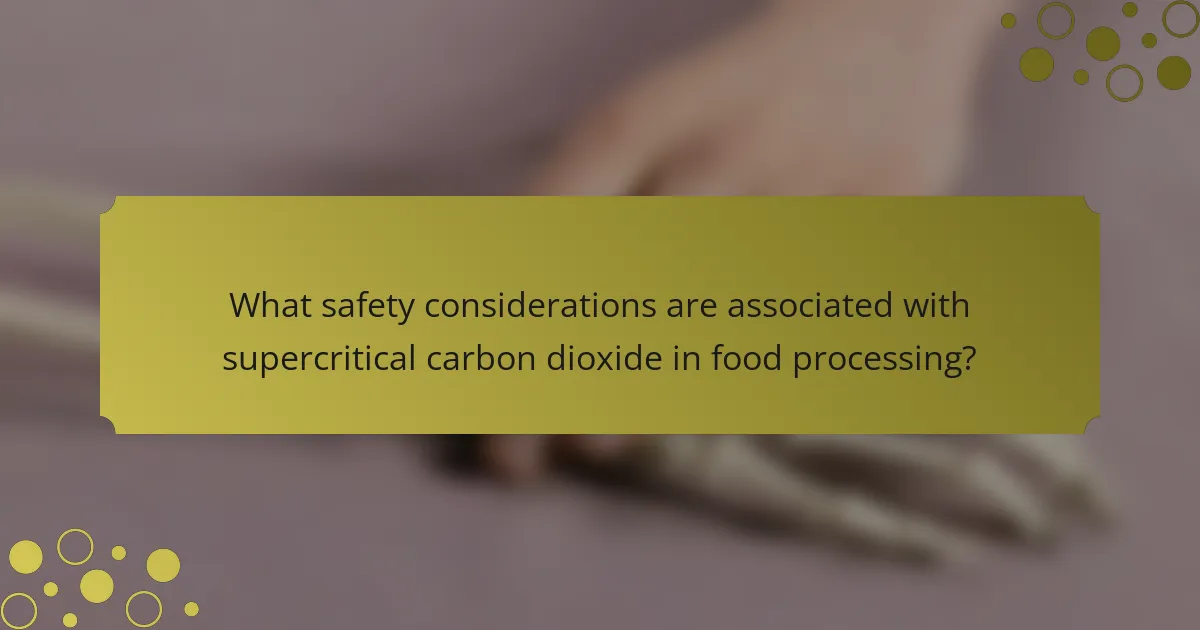
What safety considerations are associated with supercritical carbon dioxide in food processing?
Supercritical carbon dioxide (scCO2) is generally considered safe for food processing. However, several safety considerations must be addressed. First, scCO2 is stored under high pressure, which poses risks of explosion if not managed properly. Second, the process requires careful temperature control to prevent any thermal hazards. Third, scCO2 can cause asphyxiation in poorly ventilated areas due to its ability to displace oxygen. Additionally, the purity of the scCO2 used is crucial to avoid contamination in food products. Lastly, operators must be trained to handle equipment safely and respond effectively to any emergencies. These considerations ensure the safe application of scCO2 in food processing.
How is the safety of supercritical carbon dioxide ensured in food applications?
The safety of supercritical carbon dioxide in food applications is ensured through strict regulatory guidelines and safety assessments. Regulatory bodies like the FDA and EFSA evaluate its use in food processing. Supercritical carbon dioxide is recognized as Generally Recognized as Safe (GRAS) for certain applications. Its low toxicity profile contributes to its safety in food environments. Additionally, the process conditions, such as pressure and temperature, are carefully controlled. These conditions prevent the formation of harmful byproducts. Studies have shown that supercritical carbon dioxide effectively eliminates pathogens without compromising food quality. Thus, its application is supported by both regulatory approval and scientific evidence.
What regulations govern the use of supercritical carbon dioxide in food processing?
The use of supercritical carbon dioxide in food processing is governed by several regulations. The U.S. Food and Drug Administration (FDA) recognizes supercritical carbon dioxide as Generally Recognized As Safe (GRAS) for food applications. This designation allows its use in extracting flavors and essential oils from food products. The Environmental Protection Agency (EPA) regulates carbon dioxide emissions under the Clean Air Act. Additionally, the Food Safety and Inspection Service (FSIS) oversees the safety of food products processed with supercritical carbon dioxide. These regulations ensure that the use of supercritical carbon dioxide is safe for consumers and the environment.
What are the potential risks and how can they be mitigated?
Potential risks of using supercritical carbon dioxide in food processing include pressure-related hazards and chemical interactions. High pressure can lead to equipment failure if not properly managed. This risk can be mitigated by using pressure-rated equipment and conducting regular maintenance. Chemical interactions may occur with certain food components, potentially affecting flavor or safety. To mitigate this, thorough testing of food materials should be conducted before processing. Additionally, worker safety is a concern due to exposure to high-pressure systems. Implementing proper training and safety protocols can reduce this risk effectively.
What environmental impacts does supercritical carbon dioxide have in food processing?
Supercritical carbon dioxide (scCO2) has several environmental impacts in food processing. It serves as a solvent that reduces the need for harmful organic solvents. This substitution minimizes chemical waste and pollution. scCO2 is non-toxic and does not contribute to air or water pollution. Its use can lead to energy savings due to lower processing temperatures. Additionally, scCO2 is derived from carbon dioxide, a greenhouse gas, which can help in carbon capture efforts. Studies show that using scCO2 can decrease the overall carbon footprint of food processing. For instance, it has been reported that scCO2 extraction can reduce energy consumption by up to 50% compared to traditional methods.
How does it compare to traditional solvents in terms of environmental footprint?
Supercritical carbon dioxide (SC-CO2) has a lower environmental footprint compared to traditional solvents. Traditional solvents often contribute to air and water pollution. They can release volatile organic compounds (VOCs) that harm the atmosphere. SC-CO2 is non-toxic and does not produce harmful emissions. It is derived from a renewable resource, making it more sustainable. Furthermore, SC-CO2 can be recycled within the process, reducing waste. Studies show that using SC-CO2 can decrease the overall carbon emissions associated with food processing. This makes it a more eco-friendly alternative in the industry.
What are the sustainability benefits of using supercritical carbon dioxide?
Supercritical carbon dioxide (scCO2) offers significant sustainability benefits in various applications. It is a non-toxic and environmentally friendly solvent, reducing the need for harmful chemicals. Using scCO2 minimizes waste production during extraction processes. It also operates at lower temperatures, conserving energy and reducing carbon footprints. scCO2 can be reused and recycled, promoting resource efficiency. Additionally, it helps in producing high-quality products without compromising safety. These factors contribute to a more sustainable approach in food processing and other industries.
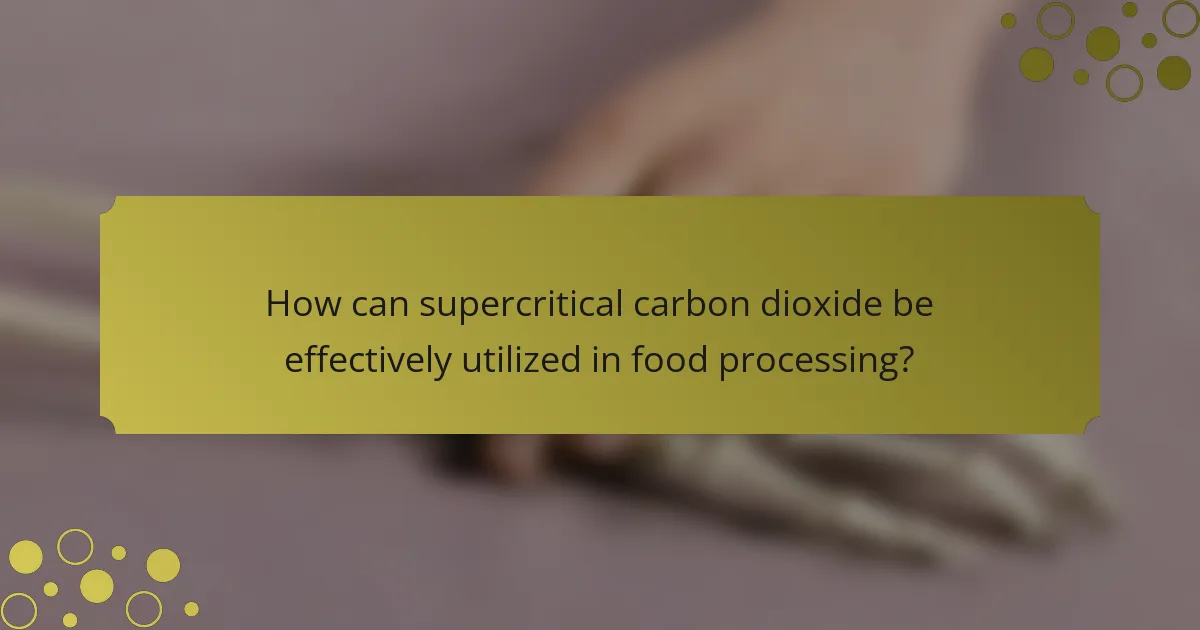
How can supercritical carbon dioxide be effectively utilized in food processing?
Supercritical carbon dioxide (SC-CO2) can be effectively utilized in food processing for extraction, preservation, and sterilization. SC-CO2 acts as a solvent, extracting flavors, colors, and bioactive compounds from raw materials. This method is efficient and environmentally friendly, as it avoids harmful solvents.
In extraction, SC-CO2 can isolate essential oils and antioxidants from plants. Studies show that SC-CO2 extraction yields higher quality products compared to traditional methods. For preservation, SC-CO2 inhibits microbial growth without altering food quality. This technique extends shelf life while maintaining flavor and nutritional value.
Moreover, SC-CO2 can sterilize food products. Research indicates that it effectively eliminates pathogens while preserving the integrity of the food. This non-thermal process reduces the risk of heat damage. Overall, SC-CO2 demonstrates versatility and effectiveness in enhancing food processing methods.
What are best practices for implementing supercritical carbon dioxide in food processing?
Best practices for implementing supercritical carbon dioxide in food processing include optimizing pressure and temperature conditions. Maintaining appropriate parameters enhances extraction efficiency and product quality. Regular monitoring of system integrity is crucial to ensure safety and prevent leaks. Utilizing food-grade carbon dioxide is essential for compliance with safety standards. Implementing a closed-loop system minimizes environmental impact by recycling CO2. Training personnel on operational protocols ensures proper handling and reduces risks. Conducting thorough testing of final products guarantees safety and quality. Finally, documenting processes aids in regulatory compliance and continuous improvement.
What equipment is needed for supercritical carbon dioxide processing?
Supercritical carbon dioxide processing requires several key pieces of equipment. A high-pressure pump is essential to achieve the necessary pressure for supercritical CO2. A pressure vessel is needed to contain the CO2 and the materials being processed. Temperature control systems are crucial to maintain the required temperature for supercritical conditions. Additionally, separation units are necessary to extract the desired compounds from the CO2 after processing. Finally, safety equipment, such as pressure relief valves and gauges, is vital to ensure safe operation under high pressure. Each of these components plays a critical role in the efficiency and safety of supercritical CO2 processing.
How can food processors optimize the use of supercritical carbon dioxide?
Food processors can optimize the use of supercritical carbon dioxide (SC-CO2) by adjusting temperature and pressure conditions. Precise control over these variables enhances extraction efficiency. Using SC-CO2 at optimal temperatures, typically between 30°C and 60°C, improves solubility of target compounds. Maintaining pressure levels between 1000 to 5000 psi ensures that CO2 remains in a supercritical state.
Implementing continuous flow systems can increase processing speed and reduce batch times. Utilizing co-solvents may enhance the extraction of specific compounds. Regular maintenance of equipment ensures consistent performance and reduces downtime. Training staff on SC-CO2 handling improves safety and operational efficiency.
Research indicates that SC-CO2 can extract essential oils with higher yields compared to traditional methods, validating its effectiveness. This optimization leads to better product quality and sustainability in food processing.
What future trends are expected for supercritical carbon dioxide in food processing?
Future trends for supercritical carbon dioxide in food processing include increased adoption for extraction and preservation. This method offers a non-toxic alternative to traditional solvents. As sustainability becomes a priority, supercritical CO2 aligns with eco-friendly practices. Enhanced efficiency in extraction processes is expected, improving yield and quality. Innovations in technology will likely reduce operational costs. Research indicates growing interest in its application for flavor enhancement and food safety. Regulatory support may further drive its use in the food industry. Overall, the trend points towards broader acceptance and integration in food processing.
How might advancements in technology impact its use?
Advancements in technology may enhance the efficiency and effectiveness of supercritical carbon dioxide (scCO2) in food processing. Improved equipment can increase extraction rates and reduce processing times. Enhanced sensors and monitoring systems can ensure optimal conditions during the scCO2 process. Automation technologies can streamline operations, minimizing human error and increasing consistency in food quality. Research has shown that technological innovations can lower energy consumption, making scCO2 processing more sustainable. Moreover, advancements in material science can lead to better containment systems, improving safety and reducing leaks. Overall, technology can significantly optimize the use of scCO2 in food processing, leading to greater economic and environmental benefits.
What new applications are being explored for supercritical carbon dioxide?
New applications being explored for supercritical carbon dioxide include food extraction, enhanced oil recovery, and carbon capture. In food processing, it is used for extracting flavors and nutrients from plants. This method is efficient and environmentally friendly. Enhanced oil recovery utilizes supercritical carbon dioxide to improve oil extraction from reservoirs. It increases the yield while reducing environmental impact. In carbon capture, supercritical carbon dioxide is employed to store CO2 emissions safely underground. These applications demonstrate the versatility and potential of supercritical carbon dioxide across various industries.
What tips should food processors follow when using supercritical carbon dioxide?
Food processors should ensure proper temperature and pressure control when using supercritical carbon dioxide. Maintaining optimal conditions enhances extraction efficiency. Operators must also regularly calibrate equipment to ensure precision. Additionally, food processors should conduct stability tests on the products. This ensures that the supercritical CO2 does not negatively impact food quality. Proper handling and safety protocols must be followed to mitigate risks. Training staff on supercritical fluid technology is essential for effective operation. Regular maintenance of the system will prevent breakdowns and ensure consistent performance.
Supercritical carbon dioxide (SC-CO2) is a unique state of carbon dioxide utilized in food processing for extraction, preservation, and sterilization. This method offers numerous advantages, including non-toxicity, environmental sustainability, and enhanced product quality. The article explores the properties of SC-CO2, its operational mechanisms, safety considerations, and regulatory guidelines. It also highlights the environmental impacts and potential risks associated with its use, along with best practices for implementation in food processing. Additionally, future trends and new applications of SC-CO2 in various industries are examined.
